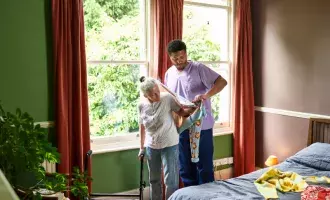Capita and the Local Government Chronicle hosted a webinar to bring together local government experts and discuss how to secure funding to help revitalise our high streets. We spoke about the importance of regeneration, the visitor economy, infrastructure, and the repurposing of buildings as we looked at the potential for high streets in 2030.
Nick Golding, editor of the Local Government Chronicle recently hosted a webinar with senior local government officials on the 2030 high street.
The Covid-19 pandemic has accelerated the shift to online shopping and store closures, so we wanted to explore how councils can rejuvenate their town centres by giving them a new purpose.
Nick firstly pointed out that; “The danger is that our high streets are empty, unloved, and purposeless”. This means there is some urgency to support approaches which can reverse or pre-empt that trend, such as regeneration, the visitor economy, heritage broadbands, infrastructure, and the repurposing of buildings.
Rob Walsh, Chief Executive of North East Lincolnshire Council spoke about the achievements of its pioneering town deal. He said that the North East Lincolnshire Council with the Greater Grimsby Town Deal “articulated a clear and a bold ambition for change and growth of our place, embracing a very proud heritage but also looking towards a very exciting future.” Rob explained that the deal focuses on four key pillars:
- Driving economic growth
- Accelerating housing delivery
- Education and skills
- Town centre and port regeneration.
The success of the town deal has become the foundation of the borough’s economic strategy and has led to successful funding from the Culture Development Fund, the Future High Streets Fund and numerous public realm investments.
Rob explained that the council’s challenge now is to meet the expectations that have been raised and to find “the capacity to deliver, the capacity to sustain the pace of change and to create an environment — particularly a town centre and high street — that looks and feels vibrant, feels local and continues to celebrate our past, and embraces a very different future.”
Matt Lamb, Director of Growth & Regeneration at Newark and Sherwood District Council explained how the council has used the purchase and redevelopment of assets for regeneration purposes within its overall town strategy and investment plan. He highlighted that the vision, ambition, and delivery required for regeneration all stem from leadership; not just the leadership of senior council officials but “equally leadership from other sectors, other areas of government, the public, and the voluntary sector. All of whom have come together to deliver as part of our agenda.”
Matt gave specific examples of properties where the council has intervened and outlined lessons learned, which include:
- The importance of pre-feasibility planning so that an opportunity can be taken quickly when it comes up
- The value of sourcing funding for capital, which can absorb ongoing revenue pressures
- How joint ventures with developers and funders can deliver successful projects
- How important it is to give the market confidence that there is an appetite to intervene, and a willingness and ability to access funding, as well as the political and professional support to back it up with action.
Robert Gatensbury, Programme Manager for Chester Regeneration at Chester and Cheshire West Council, spoke about the One City regeneration plan, which focuses on the vital visitor economy and finding new uses for the city centre. Robert mentioned key projects of Destination Chester, such as Inside Out, which positions Chester and Cheshire West as a standout destination for short breaks and spending time outdoors in a safe and secure way. As Robert explained, the investment highlights “the importance of bringing culture and a sense of place to our area which in turn positively impacts on the high streets, increases foot fall, and hopefully spend and dwell-time with local businesses”. In addition, the Chester High Street Heritage Action Zone supported by Historic England is improving the infrastructure of the historic Rose in Chester shopping centre, adding pop-up stores in vacant areas and a new boutique hotel.
Michael Couglin, Deputy Chief Executive at Surrey County Council, shared the process being using to re-imagine its town centres. Michael said: “This is a golden opportunity — a once in a generation opportunity — to genuinely reimagine what our high streets are.” The council has taken its lead from research and engagement to mock-up what local communities want for their high streets, believing that the process requires extensive and early engagement and collaboration with local communities.
The council has produced a concept for discussion and comment that suggests the types of uses that could be catered for in a future high street. For example, a health centre, library, live music venue, traditional and pop-up retail, more hospitality, and converting old office blocks for residential use. Also featured are arts activities, a community kitchen, cookery school, an open-air market, green corridors, electric vehicle charging points, and car parks out towards the fringes. Michael said: “When we’ve used this visualisation, we’ve genuinely engaged people. We’ve found it a really useful way to open up discussions for people to create that vision for their high street in all its glory.”
Margie Burgess, Capita’s Partnership Director, agreed that local leadership, community engagement, engaging the market, and government funding were all important. However, she emphasised that although it’s not clear how the current remote work trend will play out, people are likely to do more shopping close to home, creating many small high streets, and that town centres are likely to become social central districts as well as central business districts. She said; “We need to make sure that whatever we do does put the heart back into places and if people are working from home, then their local high streets will become more important to them for a variety of reasons.”
Margie supported a strong focus on community engagement and argued for getting a broad range of views. That way, issues such as the needs of children and families, mental health, opportunities to socialise and to get fresh air, environmental concerns, opportunities for cycling, and catering for physical disability would be brought into consideration. She said that, from the perspective of those responsible for urban regeneration projects, the most important considerations were funding, changing designs and planning considerations; “In many areas we need to go for urban architecture that is softer, more fluid, more natural, less municipal, to attract people in. Also making sure that in areas where we’ve built a lot of houses, we also consider that there needs to be a social hub because that heart is felt to be lacking.”
Our expert speakers demonstrated there are many successful case studies across local government where councils have devised visions for their towns and, in many cases, been successful in winning funding for their local place. The key ingredients that these examples have emphasised is the importance of developing a vision before applying for funding, engaging early and deep, developing the visitor economy, heritage areas, infrastructure, and the repurposing of buildings.







